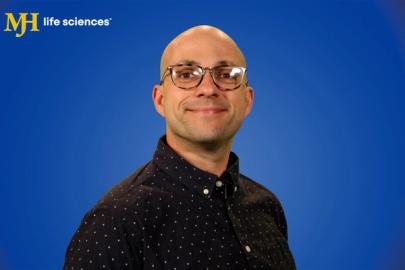- About Us
- Advertise / Support
- Editorial Board
- Contact Us
- CancerNetwork.com
- TargetedOnc.com
- OncLive.com
- OncNursingNews.com
- Terms & Conditions
- Privacy
- Do Not Sell My Information
© 2025 MJH Life Sciences™ and CURE - Oncology & Cancer News for Patients & Caregivers. All rights reserved.
Study Shows Complete Response to Isa-KRD Treatment Combo in Multiple Myeloma

A nationally-published, award-winning journalist, Alex Biese joined the CURE team as an assistant managing editor in April 2023. Prior to that, Alex's work was published in outlets including the Chicago Sun-Times, MTV.com, USA TODAY and the Press of Atlantic City. Alex is a member of NLGJA: The Association of LGBTQ+ Journalists, and also performs at the Jersey Shore with the acoustic jam band Somewhat Relative.
A treatment combination of Sarclisa, Kyprolis, Revlimid and dexamethasone demonstrated a complete response in patients who were newly diagnosed with multiple myeloma.
The treatment combination of Sarclisa (isatuximab) with Kyprolis (carfilzomib), Revlimid (lenalidomide) and dexamethasone (dex) — also known as isa-KRd — for transplant-eligible patients with newly diagnosed multiple myeloma (NDMM), with or without stem cell transplant (SCT), resulted in what researchers described as deep and durable responses, including a 100% objective response rate, according to recent study findings.
Sarclisa is a CD38 monoclonal antibody that binds to the protein CD38 to help the immune system destroy cancer, according to the National Cancer Institute. The organization also states that Kyprolis is a type of drug that inhibits an enzyme called proteasome, which prevents the growth of cancer cells while killing them.
Revlimid is a drug that may help the immune system kill abnormal blood cells or cancer cells, while also preventing the growth of new blood vessels that are necessary for tumors to grow, as defined by the National Cancer Institute.
Findings from The SKylaRk Trial, a phase 2 study of isa-KRd in 50 transplant-eligible NDMM patients, were presented at the 2023 American Society of Hematology (ASH) Meeting and Exposition and published in the journal Blood.
The study included 50 patients, with a median age of 59 years, 54% of whom were male and 46% of whom had high-risk cytogenetics, with a median follow-up of 26 months.
Among 45 patients evaluable for a response after four treatment cycles, the objective response rate (ORR; percentage of people who partially or completely respond to treatment) was 100%, with 89% achieving very good partial response (VGPR) or better and 36% achieving complete response (CR) and of those, 43% being MRD-negative.
Following six cycles or eight cycles, the ORR, CR and VGPR or better were 100%, 64% and 96%, respectively, with 66% being MRD negative, said study co-author Elizabeth K. O’Donnell, MD, Director of Early Detection and Prevention at Dana-Farber Cancer Institute and an Assistant Professor of Medicine at Harvard Medical School, during a presentation of the study’s findings at ASH.
Sarclisa has been previously approved by the Food and Drug Administration (FDA) in combination with Kyprolis and dexamethasone, as well as in combination with Pomalyst (pomalidomide) and dexamethasone, for the treatment of adults with previously treated relapsed or refractory multiple myeloma.
At 24 months, the rate of progression-free survival (PFS; length of time during and after treatment when a patient lives with cancer but does not worsen) was 91.3%. The overall survival (OS; length of time from diagnosis or the start of treatment when a patient is still alive) was 95.8%.
Grade 3 or 4 (severe or life-threatening) side effects occurring in at least two patients included neutropenia (lower levels of white blood cells; 26%), elevated alanine aminotransferase (enzymes in the liver and kidney; 12%), acute kidney injury (4%), and thrombocytopenia (low platelet count; 6%), while 20% of patients experienced grade 1 or 2 infusion-related reactions.
Forty-nine percent of patients experienced grade 1 or 2 high blood pressure, while one patient each experienced grade 3 high blood pressure and a grade 3 heart attack.
Two patients each withdrew from the study due to acute kidney injury and were not evaluable at four cycles and six cycles or eight cycles because the measurable disease could only be assessed by positron emission tomography (PET) and CT scans.
There were two patient deaths, which O’Donnell said was assessed as being unrelated to treatment.
All patients in the study were treated with 4 cycles of isa-KRd, followed by stem cell collection with the option of upfront or deferred SCT.
SCT was deferred for 89% of patients, and those who received upfront SCT were treated with two additional cycles, then maintenance.
Regarding quality-of-life, researchers reported that participants experienced statistically significant within-patient improvements in global health status, physical functioning, role functioning, emotional functioning, social functioning, body image, future perspective, fatigue, pain, loss of appetite and symptoms.
There were no statistically significant changes in measurements of patients’ body composition between baseline and the completion of four cycles or consolidation/induction, and there was a significant improvement in total lean mass between baseline and end of induction adjusted when for SCT status, the study found.
For more news on cancer updates, research and education, don’t forget to subscribe to CURE®’s newsletters here.
Related Content:



